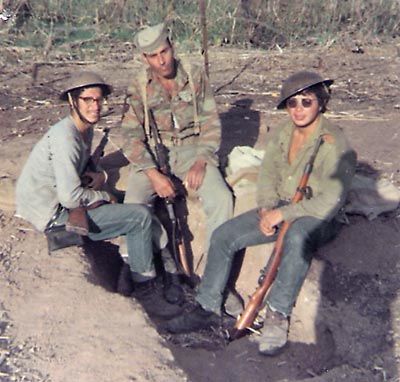The school year of 1966-1967 I spent, as a third year university student, in Israel as part of the Jewish Agency’s Youth Movement Leadership Program. The first six months, until the end of January, we were in Jerusalem’s Katamon neighborhood. Over 100 youth movement leaders from some 20 countries in North and South America, Europe, Australia and North Africa, from left to right, religious to secular. Afterwards, we all split up to engage in agricultural labour on various kibbutzim and moshavim. I ended up at Amatzia in the Lachish region.
During the “waiting period” following the events of Independence Day and the movements of Egyptian troops, my group slowly but surely began to become a part of Israel’s military defense efforts. Emergency stores were checked, equipment was reviewed, special guard duty was assigned and weapons prepared. This was not something new. Amatzia had been attacked by infiltrators several times during the short few months we had already been there. Culverts had been mined and on the evening of Independence Day, the community’s security fence had been penetrated and a house, luckily unoccupied, was attacked with explosives causing damage. The story even made the front page of Maariv newspaper.
We were visited by army commanders who explained to us all, residents and volunteers, that Amatzia lay on the direct path between Jordan and the Gaza Strip, then under Egyptian control (unlike Jordan, Egypt never absorbed the Strip or its population). Therefore, we needed to be trained in certain measures that for me seemed taken right out of films of Russian and Yugoslav partisan films made during the 1950s. I am a graduate, I want you to know, of a course in how to stop a tank using several blankets and one Molotov cocktail.
On the Sunday, June 4, I visited a group of volunteers from New York, friends of mine who by their act had launched a movement of thousands. They were staying at Mevo Betar. There we went through a special first aid course including how to carry a person wounded by a blast to his stomach so as not to have him lose any entrails or such. I left for Jerusalem on the first bus at 6 AM the next day, Monday, and just before reaching the city, the news came over the radio concerning “fierce battles in the south”. I caught a bus to Tel Aviv where I picked up another recent volunteer and we both caught the last bus south for Kiryat Gat.
 That week was one long “around-the-clock day”. Windows were lowered so that explosions would not scatter glass shards. Emergency rations were eaten. Extra hours of guard duty were added. Much time was spent in foxholes, anxiously looking east towards the Hebron Hills and the villages of Bet Awa and Idna, where Jordanian soldiers had been stationed for two weeks and where armoured vehicles had been spotted.
That week was one long “around-the-clock day”. Windows were lowered so that explosions would not scatter glass shards. Emergency rations were eaten. Extra hours of guard duty were added. Much time was spent in foxholes, anxiously looking east towards the Hebron Hills and the villages of Bet Awa and Idna, where Jordanian soldiers had been stationed for two weeks and where armoured vehicles had been spotted.
My friend, Yonel Charvit, from France, and myself, had our picture taken with an Israeli army reservist who, unfortunately, remains anonymous. I am on the left.
We had already heard Naomi Shemer’s “Jerusalem of Gold” the night it won the Song Festival competition and were aware, too, of its increasing popularity. On the war’s thrid day, the news that Jerusalem had been liberated was greeted by us all estactically. The day after the Shavuot holiday, we all were driven up to Jerusalem to visit the Western Wall and from there to Hebron, up in the hills which faced us, ominously, when we were in Amatzia.
The six days of victory were over. A new Middle East reality was beginning, one in which we are being challenged four decades later.
– Yisrael Medad


